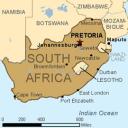– This article gives a great overview of how human consumption of meat is affecting the world. It is one of the many stories, woven of interconnections and interdependencies that form the world around us, that so many of us are ignorant of.
– I think the article is over optimistic, however, about people getting smarter about meat consumption.
– The world’s richer people will continue to consume meat much as they have. And the world’s nouveau rich, in India and China, among other places, will also step up to the table and attempt to match the meat consumption patterns of the US and Europe. This will, inevitably, drive up grain prices to feed all of these feed-lot animals and that, along with the current fad of growing crops for ethanol fuels, will further raise the prices poor folks have to pay for their food.
– So long as the rich can pay for higher priced food comfortably and so long as they hope that growing crops for ethanol will allow them to avoid the consumption down-sizing that Peak Oil implies, these trends will continue. And long before the rich say, “enough”, the poor will have been priced out of the food market and the resulting social unrest will be well underway.
= = = = = = = = = = = = = = = = =
A SEA change in the consumption of a resource that Americans take for granted may be in store — something cheap, plentiful, widely enjoyed and a part of daily life. And it isn’t oil.
It’s meat.
The two commodities share a great deal: Like oil, meat is subsidized by the federal government. Like oil, meat is subject to accelerating demand as nations become wealthier, and this, in turn, sends prices higher. Finally — like oil — meat is something people are encouraged to consume less of, as the toll exacted by industrial production increases, and becomes increasingly visible.
Global demand for meat has multiplied in recent years, encouraged by growing affluence and nourished by the proliferation of huge, confined animal feeding operations. These assembly-line meat factories consume enormous amounts of energy, pollute water supplies, generate significant greenhouse gases and require ever-increasing amounts of corn, soy and other grains, a dependency that has led to the destruction of vast swaths of the world’s tropical rain forests.
Just this week, the president of Brazil announced emergency measures to halt the burning and cutting of the country’s rain forests for crop and grazing land. In the last five months alone, the government says, 1,250 square miles were lost.
The world’s total meat supply was 71 million tons in 1961. In 2007, it was estimated to be 284 million tons. Per capita consumption has more than doubled over that period. (In the developing world, it rose twice as fast, doubling in the last 20 years.) World meat consumption is expected to double again by 2050, which one expert, Henning Steinfeld of the United Nations, says is resulting in a “relentless growth in livestock production.”
Americans eat about the same amount of meat as we have for some time, about eight ounces a day, roughly twice the global average. At about 5 percent of the world’s population, we “process” (that is, grow and kill) nearly 10 billion animals a year, more than 15 percent of the world’s total.
Growing meat (it’s hard to use the word “raising” when applied to animals in factory farms) uses so many resources that it’s a challenge to enumerate them all. But consider: an estimated 30 percent of the earth’s ice-free land is directly or indirectly involved in livestock production, according to the United Nation’s Food and Agriculture Organization, which also estimates that livestock production generates nearly a fifth of the world’s greenhouse gases — more than transportation.
To put the energy-using demand of meat production into easy-to-understand terms, Gidon Eshel, a geophysicist at the Bard Center, and Pamela A. Martin, an assistant professor of geophysics at the University of Chicago, calculated that if Americans were to reduce meat consumption by just 20 percent it would be as if we all switched from a standard sedan — a Camry, say — to the ultra-efficient Prius. Similarly, a study last year by the National Institute of Livestock and Grassland Science in Japan estimated that 2.2 pounds of beef is responsible for the equivalent amount of carbon dioxide emitted by the average European car every 155 miles, and burns enough energy to light a 100-watt bulb for nearly 20 days.
Grain, meat and even energy are roped together in a way that could have dire results. More meat means a corresponding increase in demand for feed, especially corn and soy, which some experts say will contribute to higher prices.
This will be inconvenient for citizens of wealthier nations, but it could have tragic consequences for those of poorer ones, especially if higher prices for feed divert production away from food crops. The demand for ethanol is already pushing up prices, and explains, in part, the 40 percent rise last year in the food price index calculated by the United Nations’ Food and Agricultural Organization.
More… ➡
– thx to Mike M. for pointing this story out to me.
– This article is from the NY Times and they insist that folks have an ID and a PW in order to read their stuff. You can get these for free just by signing up. However, a friend of mine suggests the website bugmenot.com  as an alternative to having to do these annoying sign ups. Check it out. Thx Bruce S. for the tip.
as an alternative to having to do these annoying sign ups. Check it out. Thx Bruce S. for the tip.

